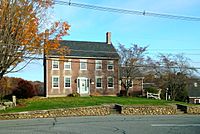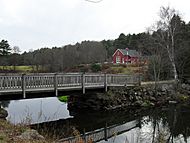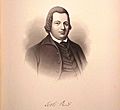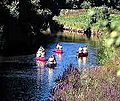Uxbridge, Massachusetts facts for kids
Quick facts for kids
Uxbridge
|
|||
|---|---|---|---|
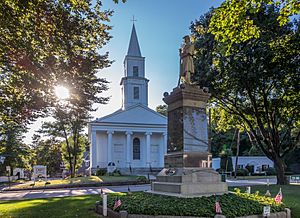
Congregational Church and Civil War Memorial
|
|||
|
|||
| Nickname(s):
"A Crossroads Village"
|
|||
| Motto(s):
"Weaving a Tapestry of Early America" and “President George Washington really did sleep here”
|
|||

Location in Worcester County and the state of Massachusetts.
|
|||
| Country | United States | ||
| State | Massachusetts | ||
| County | Worcester | ||
| Colonized | 1662 | ||
| Incorporated | 1727 | ||
| Government | |||
| • Type | Open town meeting | ||
| Area | |||
| • Total | 30.4 sq mi (78.7 km2) | ||
| • Land | 29.5 sq mi (76.5 km2) | ||
| • Water | 0.8 sq mi (2.1 km2) | ||
| Elevation | 270 ft (82 m) | ||
| Population
(2020)
|
|||
| • Total | 14,162 | ||
| • Density | 480.1/sq mi (185.1/km2) | ||
| Time zone | UTC-5 (Eastern) | ||
| • Summer (DST) | UTC-4 (Eastern) | ||
| ZIP code |
01569
|
||
| Area code(s) | 508 / 774 | ||
| FIPS code | 25-71620 | ||
| GNIS feature ID | 0618387 | ||
| Website | http://www.uxbridge-ma.gov/ | ||
Uxbridge is a town in Worcester County, Massachusetts first colonized in 1662 and incorporated in 1727. It was originally part of the town of Mendon, and named for the Earl of Uxbridge. The town is located 36 mi (58 km) southwest of Boston and 15 mi (24 km) south-southeast of Worcester, at the midpoint of the Blackstone Valley National Historic Park. Uxbridge was a prominent Textile center in the American Industrial Revolution. Two local Quakers served as national leaders in the American anti-slavery movement. Uxbridge "weaves a tapestry of early America".
Indigenous Nipmuc people near "Wacentug" or “Waentug” (river bend), deeded land to 17th-century settlers. New England towns are beginning to acknowledge their indigenous lands. Uxbridge reportedly granted rights to America's first colonial woman voter, Lydia Taft, and approved Massachusetts first women jurors. The first hospital for mental illness in America was reportedly established here. Deborah Sampson posed as an Uxbridge soldier, and fought in the American Revolution. A 140-year legacy of manufacturing military uniforms and clothing began with 1820 power looms. Uxbridge became famous for woolen cashmeres. "Uxbridge Blue", was the first US Air Force Dress Uniform. BJ's Wholesale Club distribution warehouse is a major employer today.
Uxbridge had a population of 14,162 at the 2020 United States Census.
Contents
History
Colonial era, Revolution, Quakers, and abolition
John Eliot started Nipmuc Praying Indian villages. "Wacentug" natives sold land to settlers in 1662, "for 24 pound Ster". Mendon began in 1667, and burned in King Phillips War. Western Mendon became Uxbridge in 1727, and Farnum House held the first town meeting. Nathan Webb's church, was the Colony's first new Congregational church in the Great Awakening. Lydia Chapin Taft, voted in the 1756 Town meeting, a first for women.
Seth and Joseph Read. and Simeon Wheelock joined Committees of Correspondence. Baxter Hall, was a Minuteman drummer. Seth Read fought at Bunker Hill. Washington stopped at Reed's tavern, en route to command the Continental Army. Samuel Spring, was one of the first chaplains of the American Revolution. Deborah Sampson, enlisted as "Robert Shurtlieff of Uxbridge". Shays' Rebellion also began here and Governor John Hancock quelled Uxbridge riots. Seth Reed was instrumental in adding E pluribus unum to U.S. coins. Washington slept here on his Inaugural tour.
Quakers, including Richard Mowry migrated here from Smithfield, Rhode Island, and built mills, railroads, houses, tools and Conestoga wagon wheels. Southwick's store housed the "Social and Instructive Library". Friends Meetinghouse, next to Moses Farnum's farm, had prominent abolitionists Abby Kelley Foster, and Effingham Capron as members. Capron led the 450 member local anti-slavery society. Brister Pierce, formerly a slave in Uxbridge, was a signer of an 1835 petition to Congress demanding abolition of slavery and the slave trade in the District of Columbia.
Early transportation, education, public health and safety
The Tafts built the Middle Post Road's Blackstone River bridge in 1709. "Teamsters" drove horse "team" freight wagons, on the Worcester-Providence stage route. The Blackstone Canal brought horsedrawn barges to Providence through Uxbridge for overnight stops. The "crossroads village" was a junction on the Underground Railroad. The P&W Railroad ended canal traffic in 1848.
A 1732 vote "set up a school for ye town of Uxbridge". A grammar school was followed by 13 one room district school houses, built for $2000 in 1797. Uxbridge Academy (1818), became a prestigious New England Prep School.
Uxbridge voted against smallpox vaccine . Samuel Willard (physician) treated smallpox victims, was a forerunner of modern psychiatry, and ran the first hospital for mental illness in America. Vital records recorded many infant deaths, the smallpox death of Selectman Joseph Richardson, "Quincy", "dysentary", and tuberculosis deaths. Leonard White recorded a Malaria outbreak here in 1896 that led to firsts in control of malaria as a mosquito-borne infection. Uxbridge led Massachusetts in robberies for a quarter of the year in 1922, and the town voted to hire its first night time police patrolman.
Industrial era: 19th century to late-20th century
Bog iron and three iron forges marked the colonial era, with the inception of large-scale industries beginning around 1775—examples of this development can be seen in the work of Richard Mowry, who built and marketed equipment to manufacture woolen, linen, or cotton cloth, and gristmills, sawmills, distilleries, and large industries. Uxbridge reached a peak of twenty different industrial mills. Daniel Day built the first woolen mill in 1809. By 1855, 560 local workers made 2,500,000 yards (2,300,000 m) of cloth (14,204 miles (22,859 km)). A small silver vein at Scadden, in SW Uxbridge, led to unsuccessful commercial mining in the 1830s.
Innovations included power looms, vertical integration of wool to clothing, cashmere wool-synthetic blends, "wash and wear", yarn spinning techniques, and latch hook kits. Villages included mills, shops, worker housing, and farms. Wm. Arnold's Ironstone cotton mill, later made "Kentucky Blue Jeans", and Seth Read's gristmill, later housed Bay State Arms. Hecla and Wheelockville housed American Woolen, Waucantuck Mill, Hilena Lowell's shoe factory, and Draper Corporation. Daniel Day, Jerry Wheelock, and Luke Taft used water powered mills. Moses Taft's (Central Woolen) operated continuously making Civil War cloth,
North Uxbridge housed Clapp's 1810 Cotton Mill, Chandler Taft's and Richard Sayles Rivulet Mill, the granite quarry, and Rogerson's village. Crown and Eagle Mill was "a masterpiece of early industrial architecture". Blanchard's granite quarry provided curb stones to New York City and regional public works projects. Peter Rawson Taft's grandson, William Howard Taft, visited Samuel Taft House.
John Sr., Effingham and John W. Capron's mill pioneered US satinets and woolen power looms Charles A. Root, Edward Bachman, and Harold Walter expanded Bachman-Uxbridge., and leadership in women's fashion. The company manufactured US Army uniforms for the Civil War, World War I, World War II, the nurse corps, and the first Air Force "dress uniforms", dubbed "Uxbridge Blue". Time magazine covered Uxbridge Worsted's proposed a buyout to be the top US woolen company. One of the largest US yarn companies, Bernat Yarn's largest plant was located here from the 1960s to the 1980s. A historic company called 'Information Services', operated from Uxbridge, and managed subscription services for 'The New Republic', among other publications, in the later 20th century.
Late-20th century to present
State and national parks developed around mills and rivers were restored. The Great Gatsby (1974) and Oliver's Story (1978) were filmed locally including Stanley Woolen Mill. The Blackstone Valley National Historic Park contains the 1,000-acre (4.0 km2)Blackstone Canal Heritage State Park, 9 miles (14 km) of the Blackstone River Greenway, the Southern New England Trunkline Trail, West Hill Dam, a 567-acre wildlife refuge, parcels of the Metacomet Land Trust, and Cormier Woods. 60 Federalist homes add to 54 National, and 375 state-listed historic sites, including Georgian Elmshade, (where War Secretary Alphonso Taft had recounted local family history at a famous reunion). Capron's wooden mill survived a 2007 fire at the Bernat Mill. Stanley mill is being restored while Waucantuck mill, was (mostly) razed. In 2013 multiple fires again affected this town and included a historic bank building and a Quaker home from the early 1800s. See National historic sites.
Geography
The town is 30.4 square miles (79 km2), of which 0.8 square miles (2.1 km2), or 2.73%, is water. It is situated 39.77 miles (64.00 km) southwest of Boston, 16 miles (26 km) southeast of Worcester, and 20 miles (32 km) northwest of Providence. Elevations range from 200 feet (61 m) to 577 feet (176 m) above sea level. It borders Douglas, Mendon, Millville, Northbridge, and Sutton, Massachusetts, plus the Rhode Island towns of Burrillville and North Smithfield.
Adjacent Cities and towns
 |
Sutton | Northbridge | Mendon |  |
| Douglas | Millville | |||
| Burrillville and North Smithfield, Rhode Island |
Climate
A USDA hardiness zone 5 continental climate prevails with snowfall extremes from October (rare), to May. The highest recorded temperature was 104 F, in July 1975, and the lowest, -25 F in January 1957.
| Climate data for Uxbridge, Massachusetts | |||||||||||||
|---|---|---|---|---|---|---|---|---|---|---|---|---|---|
| Month | Jan | Feb | Mar | Apr | May | Jun | Jul | Aug | Sep | Oct | Nov | Dec | Year |
| Average high °F (°C) | 37 (3) |
40 (4) |
49 (9) |
59 (15) |
70 (21) |
79 (26) |
84 (29) |
82 (28) |
75 (24) |
64 (18) |
53 (12) |
42 (6) |
61 (16) |
| Average low °F (°C) | 13 (−11) |
16 (−9) |
27 (−3) |
37 (3) |
47 (8) |
55 (13) |
60 (16) |
59 (15) |
49 (9) |
37 (3) |
30 (−1) |
20 (−7) |
38 (3) |
| Average precipitation inches (mm) | 3.6 (91) |
3.3 (84) |
4.1 (100) |
3.9 (99) |
4.3 (110) |
3.6 (91) |
3.7 (94) |
4.1 (100) |
4.1 (100) |
4.1 (100) |
4.5 (110) |
4.0 (100) |
47.3 (1,200) |
| Source: Weather.com | |||||||||||||
Demographics
| Historical population | ||
|---|---|---|
| Year | Pop. | ±% |
| 1850 | 2,457 | — |
| 1860 | 3,133 | +27.5% |
| 1870 | 3,058 | −2.4% |
| 1880 | 3,111 | +1.7% |
| 1890 | 3,408 | +9.5% |
| 1900 | 3,599 | +5.6% |
| 1910 | 4,671 | +29.8% |
| 1920 | 5,384 | +15.3% |
| 1930 | 6,285 | +16.7% |
| 1940 | 6,417 | +2.1% |
| 1950 | 7,007 | +9.2% |
| 1960 | 7,789 | +11.2% |
| 1970 | 8,253 | +6.0% |
| 1980 | 8,374 | +1.5% |
| 1990 | 10,415 | +24.4% |
| 2000 | 11,156 | +7.1% |
| 2010 | 13,457 | +20.6% |
| 2020 | 14,162 | +5.2% |
| * = population estimate. Source: United States Census records and Population Estimates Program data. |
||
The 2010 United States Census population was 13,457, representing a growth rate of 20.6%, with 5,056 households, a density rate of 166.31 units per square mile. 95.7% were White, 1.7% Asian, 0.90% Hispanic, 0.3% African American, and 1.4% other. Population density was 442.66 people/ mile2 (170.77/km²). Per capita income was $24,540, and 4.7% fell below the poverty line. There were 9,959 registered voters in 2010.
Transportation
Rail
The nearest MBTA Commuter Rail stops are Forge Park/495 on the Franklin Line and Grafton and Worcester on the Framingham/Worcester Line, 15 miles away. The Northeast Corridor Providence Amtrak station has trains with top speeds of 150 MPH. The Providence and Worcester Railroad freight line passes two former local stations.
Highways
![]() Route 146 links Worcester,
Route 146 links Worcester, ![]() I-290, and
I-290, and ![]() I-90 to Providence at
I-90 to Providence at ![]() I-95 and
I-95 and ![]() I-295.
I-295. ![]() Route 16 links to Connecticut via
Route 16 links to Connecticut via ![]() I-395, and Boston, by
I-395, and Boston, by ![]() I-495.
I-495. ![]() Route 122 connects Northbridge and Woonsocket.
Route 122 connects Northbridge and Woonsocket. ![]() Route 146A goes into North Smithfield.
Route 146A goes into North Smithfield. ![]() Route 98 leads to Burrillville.
Route 98 leads to Burrillville.
Airports
TF Green State Airport Warwick-Providence, RI, Worcester Regional Airport, and Boston Logan International Airport have commercial flights. Hopedale Airport, 7.2 miles (11.6 km) away, and Worcester Regional Airport have general aviation. A private air strip, Sky Glen Airport on Quaker Highway, is still listed on FAA sites, though the map location shows it within a dense industrial park, and at its peak of operations, it saw very low traffic.
Points of interest
- National historic sites
- Elmshade, Site of historic Taft family reunion of 1874
- Bernat Mill, formerly Capron Mill, circa 1820, and Uxbridge Worsted Company
- Stanley Woolen Mill
- Blackstone River Valley National Heritage Corridor
- Blackstone River and Canal Heritage State Park Massachusetts Department of Conservation and Recreation park website
- West Hill Dam and recreation area
Photos
-
Nipmuck Dancing in the Blackstone Valley; The original Town of Mendon, MA was purchased from the Nipmuck in 1662 as Squinshepauk Plantation. Nipmuck are the indigenous people of Worcester County, Northeastern CT, and NW Rhode Island.
-
Coronet John Farnum, Jr., House, 1710, houses Uxbridge Historical Society, Held First Town Meeting in 1727
-
Nathan Webb's Church (1731), first new Congregational Church in Massachusetts, First Great Awakening Period. This building was built after the church's establishment in 1727, but the Congregation's original church was the first new church in that period.
-
Portrait, Rev. Samuel Spring, Old South Church, Newburyport; (1746–1819), early American Revolutionary War chaplain, Congregationalist minister, founder of Andover (now Newton-Andover) Theological Seminary and Massachusetts Missionary Society. Uxbridge native, tutored by Rev Nathan Webb
-
Lt. Colonel Seth Read, born 1746, fought at Bunker Hill, added E Pluribus Unum to coins, and founded Erie, PA, and early settlement at Geneva, New York
-
Lt. Simeon Wheelock House (1768), Deborah Wheelock Chapter, D.A.R. Lt. Wheelock, who was born in 1741, died in Shays' rebellion in 1786, while on duty protecting the Springfield Armory. Shays' Rebellion had opening salvos in Uxbridge
-
Deborah Sampson, a woman posing as a male soldier, enlisted in the Continental Army at Bellingham as "Robert Shurtlieff of Uxbridge". A minister kept her secret, and she was later honored as a heroine by the Massachusetts legislature.
-
Aaron Taft House, Hazel St. was the birthplace of Peter Rawson Taft in 1785, Grandfather of President William Howard Taft.
-
Samuel Taft House hosted President George Washington on the President's Post Inaugural Tour and hosted President William Howard Taft in 1910.
-
Friends Meeting House (1770), Quaker Highway at Route 98, Uxbridge, MA. Abolitionist Quakers with ties to Moses Brown first resettled here from Rhode Island. At least two of its members became key leaders in the national anti-slavery movement—Abby Kelley Foster and Effingham Capron.
-
Abby Kelley Foster, a member of the Uxbridge Friend's Meeting, led Susan B. Anthony and Lucy Stone to abolitionism. She became the foremost lecturer and fundraiser for the American anti-slavery society of which fellow Quaker meetinghouse member Effingham Capron became Vice President.
-
The town of Uxbridge built 13 district schoolhouses in 1797. The South Uxbridge schoolhouse today houses the south Uxbridge community association at the historic site of Ironstone, Massachusetts.
-
Jacob Aldrich house typifies the early Quaker houses at Quaker City, and South Uxbridge.
-
Uxbridge Academy & Masonic Lodge. Uxbridge Academy was a sought after New England Prep School from 1818
-
Site of the Daniel Day Mill, 1809. Daniel Day started the first woolen mill in the Blackstone Valley later also known as "Scott's Mill", the current factory recently housed Berrocoo Inc., extending a 200-year family enterprise, now a prominent yarn company..
-
Rivulet Mill Complex, 1814, North Uxbridge, The original mill was built by Chandler Taft, and later owned by Richard Sayles.
-
Richard Sayles House is a historic home built by Richard Sayles who owned the Rivulet Mill. Located at 80 Mendon Street.
-
The Capron Mill, 1820, built by John Capron Sr. and his sons Effingham, and John, circa 1820 manufactured the first satinets, used the first power looms for woolens in America, and made US military uniforms for over 140 years, including the first US Air Force dress uniform, "Uxbridge 1683", aka Uxbridge Blue.
-
Crown & Eagle Mill, built in 1824 by Robert Rogerson, a son of British immigrants, and a musician, it is considered a masterpiece of early American Industrial architecture, today the heart of Rogerson's Village Historic District.
-
Stanley Woolen Mill, 1852, built by Moses Taft, with view of the Blackstone Canal, was the scene for two movies, The Great Gatsby, 1974, and Oliver's Story, 1978. In 1989, it had been the longest continuously operating family-owned mill in the US. This mill ran 24/7 making Civil War blue woolen cloth for military uniforms.
-
Canoes on the Blackstone Canal. The Blackstone Canal was built starting in 1824 and provided early freight transport by horse pulled barges from Uxbridge and Worcester, to the port of Providence and returns. Uxbridge was the overnight stopping point, and had close mercantile ties to Providence.
-
The Taft brothers built the first bridge across the Blackstone River in 1709. This stone arch bridge is a familiar scene walking northward at the Blackstone Canal Heritage State Park.
-
Ezra Taft Benson, (1811–1869) ran a hotel in Uxbridge, married two sisters from Northbridge, LDS Apostle, Missionary to the Hawaiian Islands, and Utah Territorial Legislator
-
Arthur MacArthur, Sr., born to Scottish nobility, grew up in Uxbridge, circa 1828, became Wisconsin's 4th Governor for a brief period, and its Lt. Governor, and served as Chief Justice, of the US DC District Court. He was the Grandfather of General Douglas MacArthur
-
Unitarian Church at Uxbridge where Judge Henry Chapin, three term Worcester Mayor, delivered a famous 1864 published historical address. Judge Chapin was as a prominent Unitarian Church leader in Massachusetts. This church was prominent in the Industrial period of this community.
-
Judge Henry Chapin, 2nd Mayor of Worcester, 1849–1851), three term Mayor, Chief Judge, and Practicing Attorney who lived in Uxbridge, and delivered a famous historical address to the Uxbridge Unitarian Church in 1864 recording the account of America's First Woman Voter, Lydia Taft
-
Effingham Capron (1791–1859) was a national, state and local anti-slavery champion. He and his brother John Capron, Jr and their father, ran the Capron Mill at Uxbridge. The historic park commemorates the contributions of Effingham Capron here and to the USA.
-
Arthur K. Wheelock, Jr, National Gallery Curator Northern Baroque Art, grew up in Uxbridge family which had started and operated multiple mils for 200 years. A descendent of Rev. Ralph Wheelock who pioneered public education in America.
Economy
High tech, services, distribution, life sciences, hospitality, local government, education and tourism offer local jobs. A 618,000 square feet (57,400 m2) distribution center serves Fortune 500 BJ's Wholesale Club's, northern division. Unemployment was 3.9%, lower than the state average .
Education
Local schools include the Earl D. Taft Early Learning Center (Pre-K–3), Whitin Intermediate School (4–7), Uxbridge High School (8–12), and Our Lady of the Valley Regional.
Uxbridge is also a member of one of the thirteen towns of the Blackstone Valley Regional Vocational School District. Uxbridge students in eighth grade have the opportunity to apply to Blackstone Valley Regional Vocational Technical High School, serving grades 9–12.
The New York Times called Uxbridge education reforms a "little revolution" to meet family needs.
Notable people
- Benjamin Adams, Congressman
- Willard Bartlett, New York Chief Justice
- Franklin Bartlett, Congressman
- Ezra ("T".) Taft Benson, was an LDS Church Apostle, Hawaii missionary, and Utah legislator. Chandler Taft built the 1814 Rivulet Mill
- Alice Bridges, won an Olympic bronze in Berlin
- Phineas Bruce, Congressman
- Edward P. Bullard, started Bullard Machine tools, whose designs enabled auto manufacturing and industry
- Effingham Capron, led Uxbridge as a center for pre-Civil War anti-slavery activities, and was a state and national anti-slavery leader, and an industrialist
- Daniel Day, a Taft, started the third US woolen mill
- Tim Fortugno, played for the California Angels and Chicago White Sox
- Albert Harkness, Uxbridge High; academic latin scholar; published multiple works
- Jacqueline Liebergott, was president of Emerson College
- Arthur MacArthur Sr., was a Lt. Governor, Chief Justice and Douglas MacArthur's grandfather
- Joshua Macomber, Educator
- Richard Moore, recent Senate President Pro Tem (MA), was a FEMA executive, a past President of the Conference of State Legislatures, and a principal architect of Massachusetts's landmark health care law
- William Augustus Mowry, Educator
- Jeannine Oppewall, has four Academy Award nominations for best art direction
- Willard Preston, the 4th University of Vermont President, published famous sermons while later serving the Independent Presbyterian Church of Savannah, Georgia
- Seth Reed, fought at Bunker Hill, was instrumental in adding "E pluribus unum" to U.S. coins, and was a founder of Erie, Pennsylvania and Geneva, New York
- Brian Skerry, is a National Geographic photojournalist, protecting global sea life
- Edward Sullivan, won a Congressional Medal of Honor in the Spanish–American War
- Robert Taft I, was patriarch to the Taft family political dynasty
- Robert Taft, 2nd, was a Selectman
- Josiah Taft, wealthy landowner, husband of Lydia Taft
- Lydia (Chapin) Taft, first woman to vote in America
- Bezaleel Taft Sr., served as an American Revolution Captain, state representative and state senator
- Bezaleel Taft Jr., state representative and state Senator. Owned historic Elmshade Taft Family homestead
- Samuel Taft, hosted George Washington on his post-inaugural tour
- Luke Taft, built two water powered textile mills
- Moses Taft, built Stanley Woolen Mill
- Peter Rawson Taft I, was the grandfather of William Howard Taft
- Nathan Webb, First called minister at new Congregational Church, first mentioned in Great Awakening period, was John Adams‘ uncle
- Arthur K. Wheelock Jr., was curator of Northern Baroque Art at the National Gallery of Art from 1975 to his retirement in 2018
- Paul C. Whitin, founded the Whitin Machine Works; transformed cotton machine manufacturing
- Charles Vacanti, Anasthesiologist; Tissue engineering; Stem Cells; Known for the Vacanti Mouse
Images for kids
See also
 In Spanish: Uxbridge (Massachusetts) para niños
In Spanish: Uxbridge (Massachusetts) para niños




